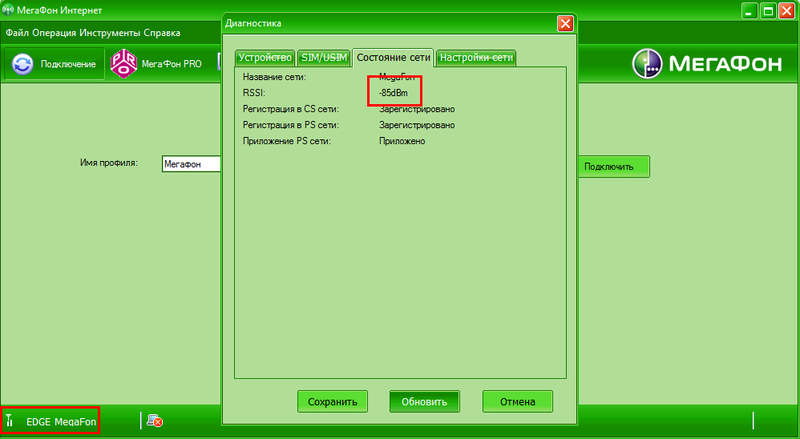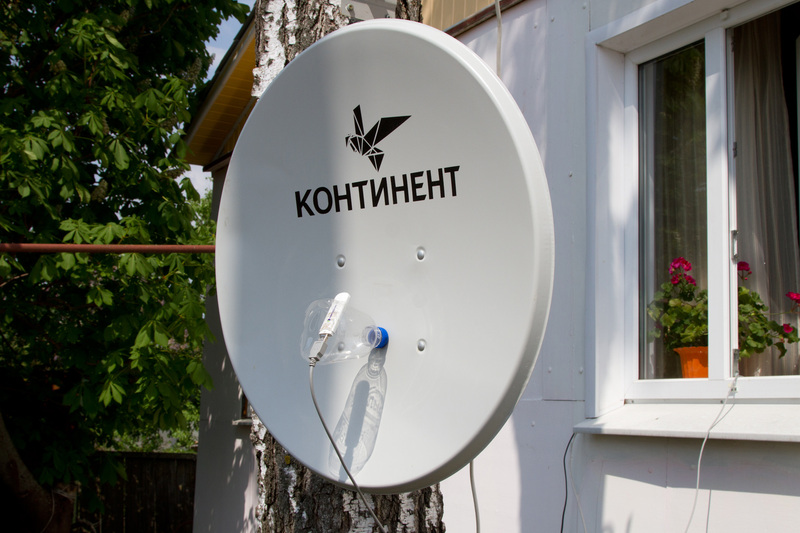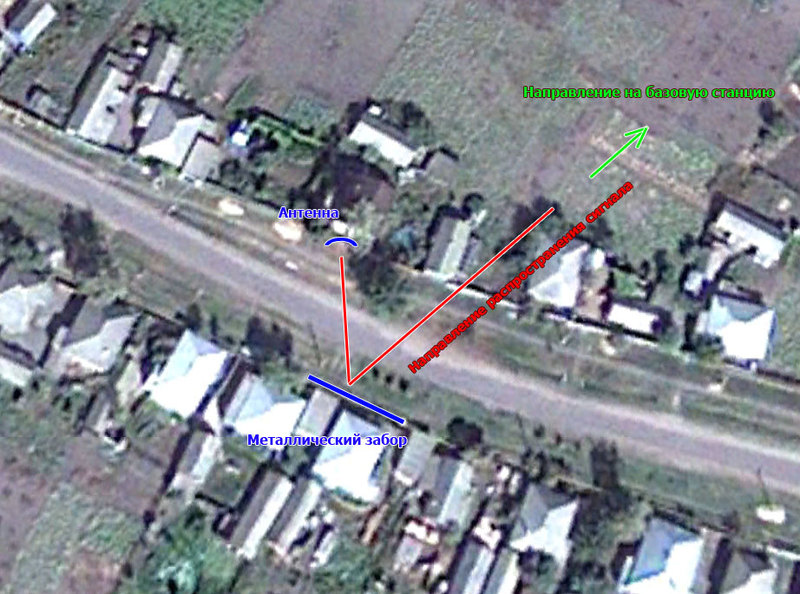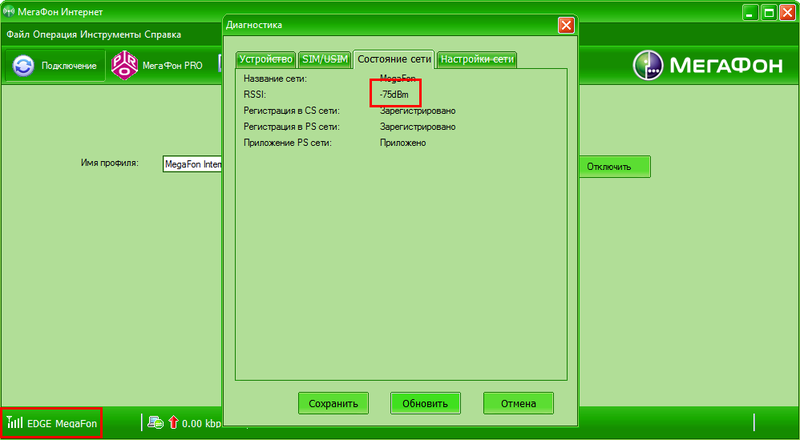Connecting GPRS-Internet in the village
Warm days came, hot summer ahead, and May holidays lowered moods. All this leaves almost no desire to spend Sundays in the corners of a non-spacious city apartment, but I want freedom, fresh village air, the smell of hay, grass wet from the dew and the light of twinkling stars that have passed thousands of light years and can be seen through the abyss of uncharted dark matter.
Accustomed to the conditions of modern civilization, I no longer imagine a long-term life without the presence of the Internet at hand, and in the modern Russian conditions of its development in the provincial backwater, its accessibility leaves much to be desired. Therefore, my task was to implement the possibility of obtaining broadband access to the Internet where it does not exist.
(many pictures)
The country house, in which I decided to hold the Internet, is located at a distance of 100 km from the regional center of Voronezh. And although, according to the data of the Megafon, Beeline, MTS coverage map, the connection must be present at this point and even with 3G elements — the usual phone finds the signal only in certain enchanted places in the garden. In this area with a fairly confident GSM signal, only Tele2 is present. But it just so happened that Tele2 in our region does not provide unlimited Internet access tariffs, and the limit tariffs in our time are no longer comfy.
')
I used the long-acquired Huawei E1550 Megaphone modem, unlocked for use with other telecom operators.
Below is a screenshot of the program window that comes with the modem, which shows the signal level of a 2G network Megaphone received by a modem connected to a laptop in a clean garden (-91 dB, no EDGE signal sticks).

Below is a screenshot and shows the level of the signal received by the modem, thrown on a tree to a height of 2.85 m (-85 dB, two sticks of the signal EDGE).

Thus, the task was formalized as the need to install equipment that amplifies a GSM signal in order to organize a confident connection to the networks of the above-mentioned operators. After studying the issue of methods and methods for improving the quality of communication, I decided to focus on using a dish antenna for reflecting and concentrating the signal in the GSM antenna modem area.
As such an antenna I decided to use a parabolic offset (asymmetric) antenna for receiving a satellite signal Continent with a diameter of 0.66 m. Why exactly 0.66 m? Antennas with a diameter of 0.5 m have a gain of ~ 18 dB, 0.6 m about 20 dB, 0.9 m about 23 dB. Installing an antenna with a diameter of 0.8 m is quite troublesome (I already had to install an antenna of 0.8 m for the Continent). A small antenna with a diameter of 0.5 m counted has insufficient gain. Therefore, I stopped at a size of 0.6 m, but only 0.66 m was available at the store. Thus, the approximate gain of this antenna should be about 21 dB.
Then there was a choice between two options - install an irradiator for receiving a GSM signal on the antenna and modify the GSM modem by soldering an adapter for connecting an external antenna to it (as described here ), or place the modem directly on the antenna without modification.
The advantages of the first method are the best lightning protection, regular placement of the components of the receiving path, sufficient cable length to the computer to place the antenna in any convenient place. The disadvantages include the increased cost and the need to modify the modem. The second method is distinguished by its advantage - ease of use, but it has an important disadvantage - the absence of lightning protection, which can lead to the failure of both the modem and usb port of the computer, as well as the limitation on the length of the usb cable.
If you close your eyes on lightning protection and do not use a computer during a thunderstorm with a high probability of being struck by lightning, then the second method outweighs the scale and I used it to implement the idea.
WARNING! When you repeat the design, the risk of a lightning strike to the modem and disabling it and the associated equipment from the system you assume!
As a cable connecting the computer and the modem used a usb extension for 5 meters with a ferrite ring at the end.
Initially, I installed the modem in a standard mount for the irradiator on the antenna. But this method of installation, for some reason, did not bring any significant changes in the quality of the received signal. I had to experiment for a long time to find the most successful position of the modem, with respect to the antenna, at which there was at least some gain effect. As it turned out, it is not so simple. The distance from the modem to the antenna surface significantly affects the gain. Literally 2-3 cm farther or closer and the difference in the level of the received signal reaches 10-15 dB. Similarly, the rotation of the modem's plane relative to the antenna is strongly influenced. As a result, a position was found at which the gain of the received signal is more or less stable.

It turned out to be quite strange for me. But, apparently, due to the fact that the antenna is an asymmetrical cut from a paraboloid of rotation, the focus of such an antenna is located below the geometric center of the antenna. However, the best reception by the modem is noted when it is not at the focus of the antenna, but closer to it at a distance of about 10 cm and its plane is inclined to the antenna.

To fix the modem in this position, I cut a piece of it from the side of the plastic bottle and drilled a hole in the antenna and neck, fixed it to the antenna. Having made a knife in the bottle, the slits for the “nose” of the modem and the usb cable, we can fix it with an adhesive tape on this design. In a good way, it would be necessary to put this design in a plastic bag and hermetically pack it so that no rain drops fall on the modem.

The antenna was fixed on a tree standing next to the house, from the side of the room where the computer is located.

Due to the fact that the room is on the other side of the building, relative to the direction to the base station, and the length of the usb cable does not allow it to be taken to the right place of installation, we had to catch the reflected signal from the houses opposite. Fortunately, the neighboring house opposite the fence was made of metal and of considerable length (4-5 m), which made it possible to catch the signal reflected from it almost without loss.

According to the results of the tests, it was possible to achieve the received signal level up to -75 dB and the full five EDGE signal sticks. The gain relative to the original signal was 16 dB (at the maximum 21 dB for this antenna), which is not bad at all.

With such a signal, the modem confidently keeps the connection, quickly connects to the Internet and practically does not break the connection. However, the access speed just hit.

The average acquisition rate was about 40 kbps. The maximum was increased to 150 kbps in the morning, in the evening it dropped to 20 kbps. Ping about 500 ms. In the world of tanks you will not play :)
Of course, the above method of improving the quality of Internet connection gave its results - instead of the absence of the Internet, we did get 40-50 kbit / s of unlimited Internet. However, Tele2, without any wisdoms in this area, gives all permissible 236 kbit / s for EDGE. About 3G dream and not necessary.
Accustomed to the conditions of modern civilization, I no longer imagine a long-term life without the presence of the Internet at hand, and in the modern Russian conditions of its development in the provincial backwater, its accessibility leaves much to be desired. Therefore, my task was to implement the possibility of obtaining broadband access to the Internet where it does not exist.
(many pictures)
The country house, in which I decided to hold the Internet, is located at a distance of 100 km from the regional center of Voronezh. And although, according to the data of the Megafon, Beeline, MTS coverage map, the connection must be present at this point and even with 3G elements — the usual phone finds the signal only in certain enchanted places in the garden. In this area with a fairly confident GSM signal, only Tele2 is present. But it just so happened that Tele2 in our region does not provide unlimited Internet access tariffs, and the limit tariffs in our time are no longer comfy.
')
I used the long-acquired Huawei E1550 Megaphone modem, unlocked for use with other telecom operators.
Below is a screenshot of the program window that comes with the modem, which shows the signal level of a 2G network Megaphone received by a modem connected to a laptop in a clean garden (-91 dB, no EDGE signal sticks).

Below is a screenshot and shows the level of the signal received by the modem, thrown on a tree to a height of 2.85 m (-85 dB, two sticks of the signal EDGE).

Thus, the task was formalized as the need to install equipment that amplifies a GSM signal in order to organize a confident connection to the networks of the above-mentioned operators. After studying the issue of methods and methods for improving the quality of communication, I decided to focus on using a dish antenna for reflecting and concentrating the signal in the GSM antenna modem area.
As such an antenna I decided to use a parabolic offset (asymmetric) antenna for receiving a satellite signal Continent with a diameter of 0.66 m. Why exactly 0.66 m? Antennas with a diameter of 0.5 m have a gain of ~ 18 dB, 0.6 m about 20 dB, 0.9 m about 23 dB. Installing an antenna with a diameter of 0.8 m is quite troublesome (I already had to install an antenna of 0.8 m for the Continent). A small antenna with a diameter of 0.5 m counted has insufficient gain. Therefore, I stopped at a size of 0.6 m, but only 0.66 m was available at the store. Thus, the approximate gain of this antenna should be about 21 dB.
Then there was a choice between two options - install an irradiator for receiving a GSM signal on the antenna and modify the GSM modem by soldering an adapter for connecting an external antenna to it (as described here ), or place the modem directly on the antenna without modification.
The advantages of the first method are the best lightning protection, regular placement of the components of the receiving path, sufficient cable length to the computer to place the antenna in any convenient place. The disadvantages include the increased cost and the need to modify the modem. The second method is distinguished by its advantage - ease of use, but it has an important disadvantage - the absence of lightning protection, which can lead to the failure of both the modem and usb port of the computer, as well as the limitation on the length of the usb cable.
If you close your eyes on lightning protection and do not use a computer during a thunderstorm with a high probability of being struck by lightning, then the second method outweighs the scale and I used it to implement the idea.
WARNING! When you repeat the design, the risk of a lightning strike to the modem and disabling it and the associated equipment from the system you assume!
As a cable connecting the computer and the modem used a usb extension for 5 meters with a ferrite ring at the end.
Initially, I installed the modem in a standard mount for the irradiator on the antenna. But this method of installation, for some reason, did not bring any significant changes in the quality of the received signal. I had to experiment for a long time to find the most successful position of the modem, with respect to the antenna, at which there was at least some gain effect. As it turned out, it is not so simple. The distance from the modem to the antenna surface significantly affects the gain. Literally 2-3 cm farther or closer and the difference in the level of the received signal reaches 10-15 dB. Similarly, the rotation of the modem's plane relative to the antenna is strongly influenced. As a result, a position was found at which the gain of the received signal is more or less stable.

It turned out to be quite strange for me. But, apparently, due to the fact that the antenna is an asymmetrical cut from a paraboloid of rotation, the focus of such an antenna is located below the geometric center of the antenna. However, the best reception by the modem is noted when it is not at the focus of the antenna, but closer to it at a distance of about 10 cm and its plane is inclined to the antenna.

To fix the modem in this position, I cut a piece of it from the side of the plastic bottle and drilled a hole in the antenna and neck, fixed it to the antenna. Having made a knife in the bottle, the slits for the “nose” of the modem and the usb cable, we can fix it with an adhesive tape on this design. In a good way, it would be necessary to put this design in a plastic bag and hermetically pack it so that no rain drops fall on the modem.

The antenna was fixed on a tree standing next to the house, from the side of the room where the computer is located.

Due to the fact that the room is on the other side of the building, relative to the direction to the base station, and the length of the usb cable does not allow it to be taken to the right place of installation, we had to catch the reflected signal from the houses opposite. Fortunately, the neighboring house opposite the fence was made of metal and of considerable length (4-5 m), which made it possible to catch the signal reflected from it almost without loss.

According to the results of the tests, it was possible to achieve the received signal level up to -75 dB and the full five EDGE signal sticks. The gain relative to the original signal was 16 dB (at the maximum 21 dB for this antenna), which is not bad at all.

With such a signal, the modem confidently keeps the connection, quickly connects to the Internet and practically does not break the connection. However, the access speed just hit.

The average acquisition rate was about 40 kbps. The maximum was increased to 150 kbps in the morning, in the evening it dropped to 20 kbps. Ping about 500 ms. In the world of tanks you will not play :)
Results
Of course, the above method of improving the quality of Internet connection gave its results - instead of the absence of the Internet, we did get 40-50 kbit / s of unlimited Internet. However, Tele2, without any wisdoms in this area, gives all permissible 236 kbit / s for EDGE. About 3G dream and not necessary.
Source: https://habr.com/ru/post/143641/
All Articles